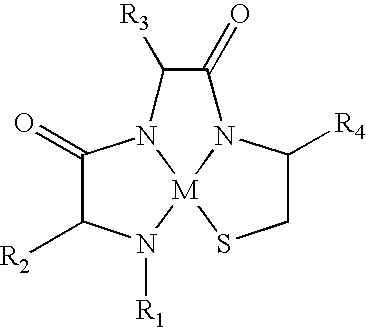Metallopeptide compounds
a technology of peptides and compounds, applied in the field ofmetallopeptides, can solve the problems of short half-life in vivo, and achieve the effect of high specificity
- Summary
- Abstract
- Description
- Claims
- Application Information
AI Technical Summary
Problems solved by technology
Method used
Image
Examples
example 1
Alpha-MSH with L-Cys Insertion
[0123]The first unnumbered peptide (SEQ ID NO:71) in Table 1 is the parent polypeptide, which is an α-MSH analog specific for melanocortin receptors. In particular, it is specific for MC1-R and binds with moderate affinity to MC3-R and MC4-R. It binds very weakly to MC5-R. Peptides were synthesized by conventional solid phase synthetic techniques, complexed with rhenium, separated from solid phase and purified by HPLC. As is well known in the art, Met is not oxidatively stable, and thus during synthesis of these peptides Met was replaced with its oxidatively stable homolog, Nle. Thus SEQ ID NO:1 was used as the template for synthesis of metallopeptides 1-1 through 1-12. The metallopeptides 1-1 through 1-12 have the presumptive metal ion complexation tri-peptide sequence identified in italics. Similarly, the italicized percent inhibition numbers represent metallopeptides wherein the secondary structure of the specific sequence responsible for binding in ...
example 2
Alphα-MSH with D-Cys Insertion
[0126]The first unnumbered peptide in Table 2 is the parent polypeptide, which is the α-MSH analog specific for melanocortin receptors of Example 1. The methods and assays set forth in Example 1 were followed. The metallopeptides 2-1 through 2-12 have the presumptive metal ion complexation tri-peptide sequence identified in italics.
[0127]
TABLE 2% Inhibition at 1 μMat MelanocortinReceptorNo.Sequence Re-Peptide1345ParentAc-Ser-Tyr-Ser-Met-99646922Glu-His-Phe-Arg-Trp-Gly-Lys-Pro-Val-NH2(SEQ ID NO:71)*2-1Ac-Ser-Tyr-Ser-Nle-97724653Glu-His-Phe-Arg-Trp-Gly-Lys-Gly-Val-D-Cys-NH22-2Ac-Ser-Tyr-Ser-Nle-93262832Glu-His-Phe-Arg-Trp-Gly-Lys-Gly-D-Cys-Val-NH22-3Ac-Ser-Tyr-Ser-Nle-91412538Glu-His-Phe-Arg-Trp-Gly-Lys-D-Cys-Pro-Val-NH22-4Ac-Ser-Tyr-Ser-Nle-91274021Glu-His-Phe-Arg-Trp-Gly-D-Cys-Lys-Pro-Val-NH22-5Ac-Ser-Tyr-Ser-Nle-43040Glu-His-Phe-Arg-Trp-D-Cys-Gly-Lys-Pro-Val-NH22-6Ac-Ser-Tyr-Ser-Nle-46266Glu-His-Phe-Arg-D-Cys-Trp-Gly-Lys-Pro-Val-NH22-7Ac-Ser-Tyr-Ser-Nl...
example 3
[Nle3, D-Phe6]-Gamma-MSH L-Cys Insertion
[0129]The first unnumbered peptide in Table 3 is the parent polypeptide, which is a Nle3, D-Phe6 substituted γ-MSH analog specific for melanocortin receptors. The methods and assays set forth in Example 1 were followed. The metallopeptides have the presumptive metal ion complexation tri-peptide sequence identified in italics, with L-Cys inserted.
[0130]
TABLE 3% Inhibition at 1 μMat MelanocortinReceptorNo.Sequence Re-Peptide1345ParentTyr-Val-Nle-Gly-His-9910099100D-phe-Arg-Trp-Asp-Arg-Phe-NH2*3-1Tyr-Val-Nle-Gly-His-959698102D-Phe-Arg-Trp-Asp-Arg-Phe-Cys-NH23-2Tyr-Val-Nle-Gly-His-999189100D-Phe-Arg-Trp-Asp-Arg-Cys-Phe-NH23-3Tyr-Val-Nle-Gly-His-99959999D-Phe-Arg-Trp-Asp-Cys-Arg-Phe-NH23-4Tyr-Val-Nle-Gly-His-988894100D-Phe-Arg-Trp-Cys-Asp-Arg-Phe-NH23-5Tyr-Val-Nle-Gly-His-83453381D-Phe-Arg-Cys-Trp-Asp-Arg-Phe-NH23-6Tyr-Val-Nle-Gly-His-52203131D-Phe-Cys-Arg-Trp-Asp-Arg-Phe-NH23-7Tyr-Val-Nle-Gly-His-39502856Cys-D-Phe-Arg-Trp-Asp-Arg-Phe-NH23-8Tyr-Val...
PUM
 Login to View More
Login to View More Abstract
Description
Claims
Application Information
 Login to View More
Login to View More - R&D
- Intellectual Property
- Life Sciences
- Materials
- Tech Scout
- Unparalleled Data Quality
- Higher Quality Content
- 60% Fewer Hallucinations
Browse by: Latest US Patents, China's latest patents, Technical Efficacy Thesaurus, Application Domain, Technology Topic, Popular Technical Reports.
© 2025 PatSnap. All rights reserved.Legal|Privacy policy|Modern Slavery Act Transparency Statement|Sitemap|About US| Contact US: help@patsnap.com


